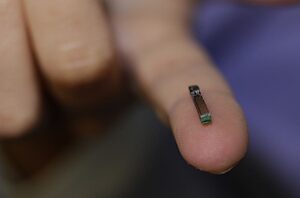
The device could prove to be extremely valuable, if not indispensable, for patients that require constant supervision or those under treatment that needs to be constantly modified.
There are literally thousands of chemicals flowing through our blood stream, and some of these substances are telltale signals of our health status. The tiny device developed by a team of researchers lead by EPFL scientists Giovanni de Micheli and Sandro Carrara, and recently presented at the DATE 13 conference, looks at the concentration of various substances in the bloodstream and delivers key information to physicians directly, no matter where the patient is located.
The tiny device is only a few cubic millimeters in volume but includes five sensors, a radio transmitter and a power delivery system. It can detect up to five proteins and organic acids simultaneously, and so far, though the device is still in its prototype stage, experiments have shown that it can reliably detect several commonly traced substances.
The detect certain substance concentrations, like those for lactate, glucose, or ATP for instance, the device’s surface is covered with an enzyme.
“Potentially, we could detect just about anything,” explains De Micheli. “But the enzymes have a limited lifespan, and we have to design them to last as long as possible.” The enzymes currently being tested are good for about a month and a half; that’s already long enough for many applications. “In addition, it’s very easy to remove and replace the implant, since it’s so small.”
The researchers at the Swiss university believe their implanted sensor would be most useful for oncology applications where patient blood tests are taken regularly in order to assess tolerance and establish treatment dosage. As such, an optimal dose will be a lot easier to prescribe and deliver. Of course, there are a myriad of conditions that require personalized treatment and this sensor might come quite in handy.
So far, the device has been tested for five different substances, and proved as reliable as traditional analysis methods.


